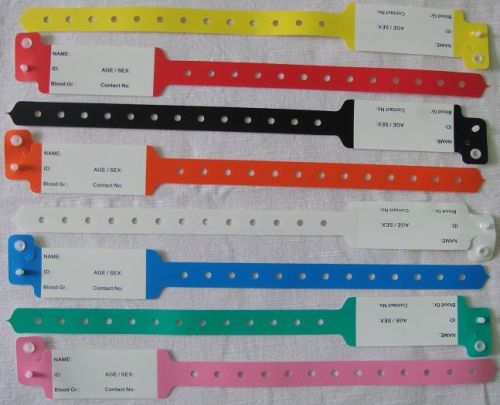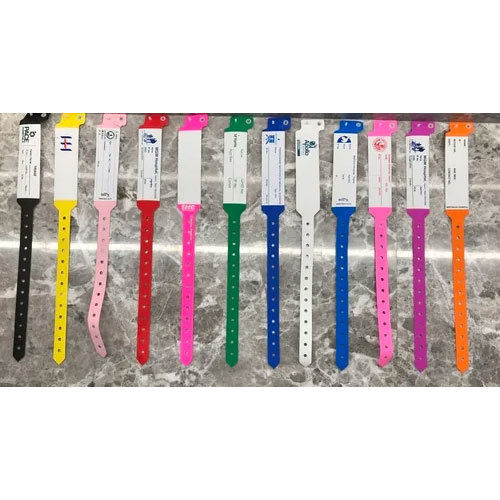The Connection Between a Patient Identification Band and Enhanced Patient Privacy
The Connection Between a Patient Identification Band and Enhanced Patient Privacy
Blog Article
Discovering the Different Kinds of Patient Identification Band Made Use Of in Clinical Facilities
In the elaborate globe of healthcare, the vital function of Patient Identification bands frequently goes undetected. These bands, varying from straightforward paper wristbands to innovative RFID bands, form the foundation of Patient safety protocols, making sure accuracy in Patient Identification. The substantial diversity of these bands, each with its special benefits and constraints, is often forgotten. As we browse with this topic, one may acquire insight right into the subtle intricacies and vital importance of such bands in medical centers.
Comprehending the Relevance of Patient Identification Bands
While they may appear like plain accessories, Patient Identification bands play a crucial role in medical centers. These bands serve as a vital device for verifying Patient identification, preventing medical mistakes associated to misidentification. The bands generally display vital info such as the Patient's name, age, blood group, and any recognized allergic reactions. They allow medical care specialists to rapidly access this critical information, thus promoting precise and punctual clinical treatment. Patient Identification bands likewise help in simplifying administrative tasks, making certain accurate record-keeping and payment. Regardless of their simpleness, these bands symbolize the principle of Patient safety and security, a keystone of quality wellness care. Without them, the threat of clinical mistakes, and consequently, Patient harm, might substantially enhance.
Standard Paper Wristbands: Their Usage and Limitations
Standard paper wristbands have actually been a staple in Patient Identification throughout numerous medical facilities. While their usage is prevalent, they nurture certain constraints that may influence their efficiency in Patient management. This section will concentrate on the extent of their application and the integral downsides connected with their usage.
Paper Wristbands: Use Range
In the realm of Patient Identification, paper wristbands have actually long held a vital duty. These bands are commonly made use of in outpatient setups, where the Patient's stay is temporary. The wristbands consist of vital details such as the Patient's name, day of birth, and an unique Identification number. This easy, yet reliable system, allows physician to swiftly and properly determine people, guaranteeing the correct treatment is administered. Paper wristbands are likewise utilized in emergency situation scenarios, where quick Identification is extremely important. Their use encompasses occasions like blood donation drives and mass inoculation programs, better emphasizing their adaptability. Despite improvements in technology, the humble paper wristband stays a reliable and affordable service for Patient Identification in numerous healthcare situations.
Limitations of Paper Wristbands
Despite their prevalent usage, paper wristbands are not without their downsides. In addition, paper wristbands typically lack the technological capacities of even more contemporary alternatives, such as barcoding or RFID chips, restricting their functionality to simply displaying created information. Paper wristbands can trigger pain or skin irritation to some individuals, particularly when used for extensive periods.
Barcoded Wristbands: Advancements in Patient Identification
While Patient Identification has actually long been a critical element of medical care, the introduction of barcoded wristbands represents a considerable leap onward. These bands leverage the simplicity of barcoding modern technology, permitting Patient details to be swiftly scanned and accessed. They improve the rate and precision of Patient Identification, minimizing the threat of medical mistakes related to misidentification. Barcoded wristbands are cost-efficient, very easy to produce, and get rid of handwriting mistakes common with hands-on systems. They are not without limitations. While they offer enhancements over typical bands, the barcode can become worn or smudged, providing it unreadable. Regardless of this, barcoded wristbands stay a vital device in modern healthcare setups, signifying the crossway of innovation and Patient care.
Radio Regularity Identification (RFID) Bands: a Step In The Direction Of Futuristic Healthcare
The evolution of Patient Identification bands has caused the development of Radio Frequency Identification (RFID) Bands (patient identification band). These ingenious devices present vital benefits for health care facilities, offering an extra reliable and technically progressed ways of Patient Identification. The execution of RFID in health care is a considerable step in the direction of an extra futuristic strategy to Patient monitoring and safety
Comprehending RFID Bands

RFID Bands: Secret Advantages
Largely, these bands enhance Patient safety and security by providing precise, immediate Identification, thereby decreasing clinical mistakes. RFID bands can save a vast amount of Patient information, consisting of clinical history and allergies, making it possible for individualized care. On the whole, RFID bands represent a considerable development in Patient Identification technology, profiting both people and medical care service providers.
Applying RFID in Medical Care
As we step into a technologically advanced era, the implementation of RFID continue reading this bands in healthcare becomes significantly essential. These bands provide a smooth means to track and recognize people, ensuring their safety and improving efficiency in treatment procedures. RFID bands offer numerous advantages over traditional Identification approaches. They can save a huge amount of information, consisting of the Patient's case history and therapy strategies, which can be quickly accessed by healthcare carriers. This data helps physicians make notified decisions concerning the Patient's therapy strategy. Moreover, RFID bands minimize medical mistakes by giving exact Patient Identification, which is crucial in protecting against misdiagnosis or incorrect medication management. Hence, the execution of RFID bands is a check my reference considerable action in the direction of improving Patient safety and medical care shipment.

Color-Coded Wristbands: Helping in Quick and Accurate Diagnosis
In the dynamic environment of a medical center, color-coded wristbands have emerged as essential tools for swift and accurate Identification of a patient's medical condition. These wristbands, put on by patients, bring certain shades that correspond to various clinical problems or statuses. This system is developed to use prompt visual cues to health care providers, enhancing Patient safety and security and care quality.
Techniques for Efficient Execution and Monitoring of Patient ID Bands
Accomplishing optimal usage of Patient Identification bands requires a well-structured strategy for their application and management. Patient education is additionally important; patients should recognize the purpose of the bands and the requirement for their consistent wear. It's necessary to have a backup strategy in place, such as barcode scanning or biometrics, to make sure that Patient Identification is never ever endangered.
Conclusion
Patient Identification bands are crucial in medical centers to ensure safety and security and precision. Efficient execution and administration of these bands can dramatically lower clinical mistakes, enhance efficiency, and boost total Patient treatment.
These bands, varying from simple paper wristbands to innovative RFID bands, develop the backbone of Patient security methods, making certain precision in Patient you could look here Identification.The development of Patient Identification bands has actually brought concerning the appearance of Radio Regularity Identification (RFID) Bands. On the whole, RFID bands stand for a substantial advancement in Patient Identification innovation, profiting both patients and healthcare companies.
RFID bands decrease medical errors by providing exact Patient Identification, which is important in stopping misdiagnosis or wrong medication administration. Patient education and learning is additionally critical; people need to comprehend the function of the bands and the need for their constant wear.
Report this page